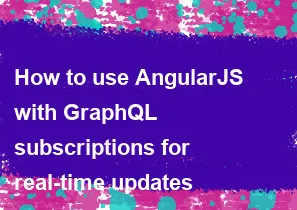How to use AngularJS with GraphQL subscriptions for real-time updates

To use AngularJS with GraphQL subscriptions for real-time updates, you'll need to integrate a GraphQL client library that supports subscriptions with your AngularJS application. Apollo Client is a popular choice for this purpose, as it provides built-in support for GraphQL subscriptions. Here's a step-by-step guide to integrating AngularJS with GraphQL subscriptions using Apollo Client:
- Install Apollo Client: First, you need to install Apollo Client and its dependencies in your AngularJS project. You can do this using npm or yarn:
bashnpm install @apollo/client graphql
- Set up Apollo Client: Initialize Apollo Client in your AngularJS application. This typically involves creating an ApolloClient instance with the appropriate URI for your GraphQL server:
javascriptimport { ApolloClient, InMemoryCache } from '@apollo/client';
const client = new ApolloClient({
uri: 'http://your-graphql-server.com/graphql',
cache: new InMemoryCache()
});
- Define GraphQL Subscription: Define your GraphQL subscription query using the
gqlfunction from@apollo/client:
javascriptimport { gql } from '@apollo/client';
export const NEW_POST_SUBSCRIPTION = gql`
subscription {
newPost {
id
title
content
}
}
`;
- Subscribe to Updates: Subscribe to the GraphQL subscription in your AngularJS component or service:
javascriptimport { NEW_POST_SUBSCRIPTION } from './graphql/subscriptions';
import { useSubscription } from '@apollo/client';
angular.module('myApp').controller('MyController', ['$scope', function($scope) {
const { data, loading, error } = useSubscription(NEW_POST_SUBSCRIPTION);
if (loading) {
// Handle loading state
}
if (error) {
// Handle error state
}
if (data) {
// Handle received data
$scope.$apply(() => {
$scope.newPost = data.newPost;
});
}
}]);
Handle Real-time Updates: Apollo Client will automatically handle real-time updates for you. When a new post is created on the server, the
dataobject in your component will be automatically updated with the new post data.Cleanup: Remember to unsubscribe from the subscription when your component is destroyed to prevent memory leaks:
javascript$scope.$on('$destroy', () => {
// Unsubscribe from subscription
});
That's it! You've now integrated AngularJS with GraphQL subscriptions using Apollo Client, allowing your application to receive real-time updates from the server. Make sure to adjust the code according to your specific GraphQL schema and application requirements.
-
Popular Post
- How to optimize for Google's About This Result feature for local businesses
- How to implement multi-language support in an Express.js application
- How to handle and optimize for changes in mobile search behavior
- How to handle CORS in a Node.js application
- How to use Vue.js with a UI framework (e.g., Vuetify, Element UI)
- How to configure Laravel Telescope for monitoring and profiling API requests
- How to create a command-line tool using the Commander.js library in Node.js
- How to implement code splitting in a React.js application
- How to use the AWS SDK for Node.js to interact with various AWS services
- How to use the Node.js Stream API for efficient data processing
- How to implement a cookie parser middleware in Node.js
- How to implement WebSockets for real-time communication in React
-
Latest Post
- How to implement a dynamic form with dynamic field styling based on user input in Next.js
- How to create a custom hook for handling user interactions with the browser's device motion in Next.js
- How to create a custom hook for handling user interactions with the browser's battery status in Next.js
- How to implement a dynamic form with dynamic field visibility based on user input in Next.js
- How to implement a dynamic form with real-time collaboration features in Next.js
- How to create a custom hook for handling user interactions with the browser's media devices in Next.js
- How to use the useSWRInfinite hook for paginating data with a custom loading indicator in Next.js
- How to create a custom hook for handling user interactions with the browser's network status in Next.js
- How to create a custom hook for handling user interactions with the browser's location in Next.js
- How to implement a dynamic form with multi-language support in Next.js
- How to create a custom hook for handling user interactions with the browser's ambient light sensor in Next.js
- How to use the useHover hook for creating interactive image zoom effects in Next.js